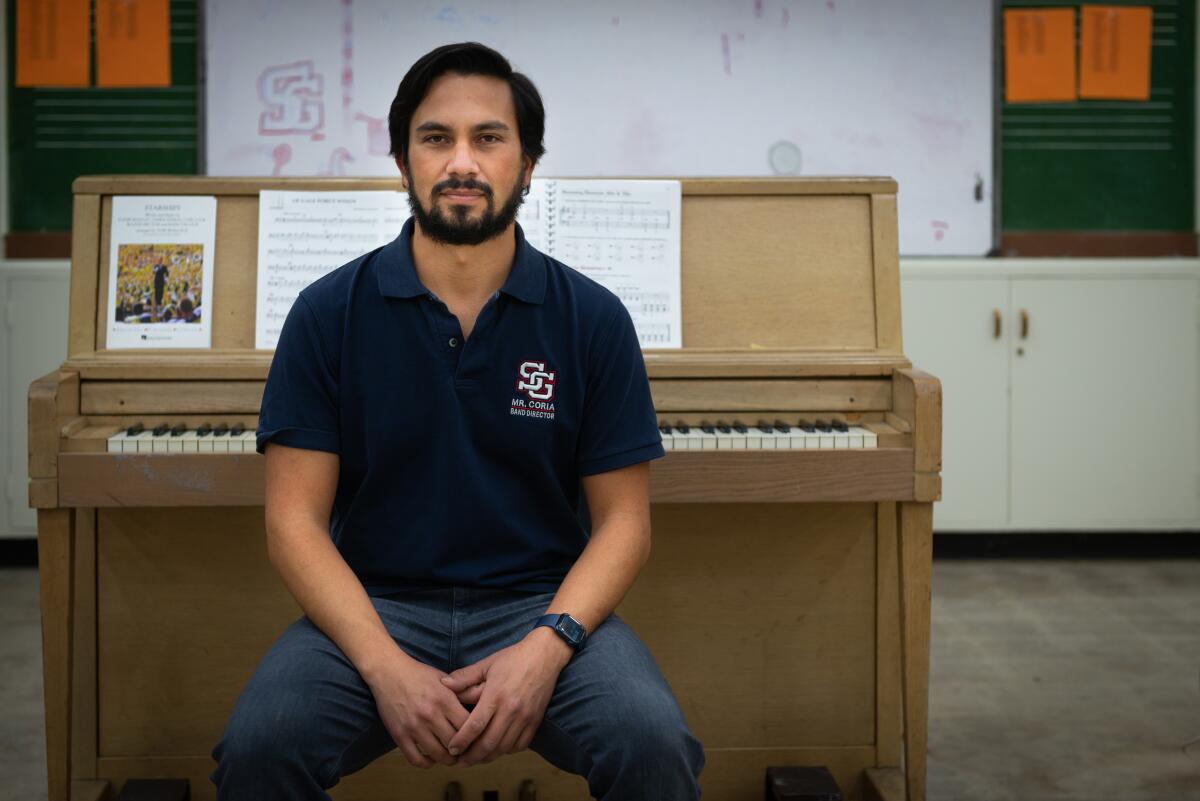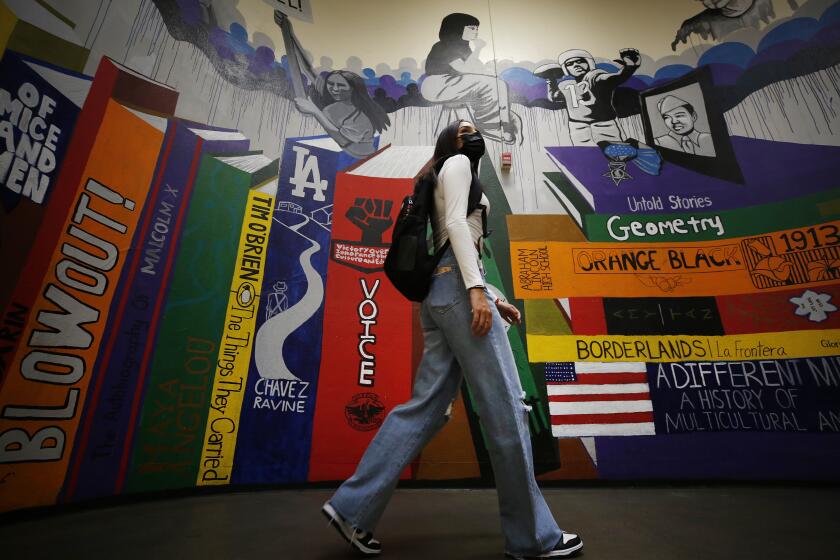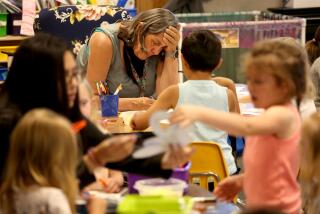New threat to COVID-era education: Black and Latino teachers are leaving the profession

- Share via
Lynette Henley needed one more year to receive her full pension after 40 years as a teacher, but she couldn’t convince herself it was worth the risk.
So Henley, 65, who has diabetes and congestive heart failure, retired last June as a math and history teacher at Hogan Middle School, in Vallejo, Calif., which serves mostly Black and Latino children.
“You’re in a classroom with 16 to 20 kids and a lot of my students weren’t vaccinated,” said Henley. “I just didn’t feel safe. It wasn’t worth it to possibly die to teach.”
Henley, who is Black, is part of a nationwide surge of teachers who are leaving the profession — especially evident among members of the profession with minority backgrounds. Amid the pandemic’s toxic brew of death, illness and classroom disruption, these departures of seasoned teachers have created another strain for students.
The California State Teachers’ Retirement System reported a 26% increase in the number of teacher retirements in the second half of 2020 compared with the same period in 2019. Of those surveyed, more than half cited challenges of teaching during the pandemic as their main reason for leaving. A national survey published by the National Education Assn. on Feb. 1 found that 55% of teachers planned to exit earlier than anticipated, up from 37% in August 2021. The numbers were highest among Black (62%) and Latino (59%) educators.
The issue was palpable when in-person classes resumed in Southern California in January. In some large districts, more than a quarter of schoolchildren were absent the first week back. Some of those who did return entered classrooms that had no teacher or were staffed by underqualified substitutes.
Bryan Monroy, an 11th-grade physics teacher at Lennox Mathematics, Science & Technology Academy in Inglewood walked into a half-empty school after winter break.
Five teachers, about a fifth of the charter school’s staff, were out, presumably sick with COVID-19 or taking care of relatives, said Monroy, 29. And that’s on top of an underlying problem hiring and holding on to staff, he said.

“We hired some people to teach chemistry and math and for whatever reason they had to resign halfway through the year during the pandemic with no one to replace them,” he said. “The kids had to finish off their year with substitutes and teacher’s aides, and that was really hard for them.”
The pandemic has been harder on teachers of color because many of them return to the communities where they were raised and which have suffered the most, Monroy said. His students are nearly all Latino and about 75% are on free or reduced lunch, he said. As the son of Mexican immigrants, he can relate to their struggles, but “because there are so many similarities that resonate between me and my kids, the vicarious trauma is also even more real.”
Studies have shown that teachers of color improve educational outcomes for students of the same background. But Black and Latino teachers tend to have shorter teaching careers than their white colleagues, according to a report by the U.S. Department of Education, which cites a lack of support and poor working conditions as the impetus for early departures.
A Los Angeles Times analysis of data offers an alarming assessment of the impact of the pandemic on L.A. students.
The Los Angeles Unified School District has been especially concerned about Black educators. The Board of Education this week passed a resolution calling on the superintendent “to take all necessary steps,” including developing a strategic plan, to recruit, develop and retain Black teachers.
About 7% of Black teachers left the nation’s second-largest school system between the prior school year and the start of this one. More than a third of the school system’s Black teachers are close to retirement.
The problem goes beyond Black teachers. Despite intensive hiring, L.A. Unified has about 500 teaching vacancies, said board member Tanya Ortiz Franklin.
In the school board’s discussion, Jackie Goldberg noted that there aren’t enough future teachers in the training pipeline and that other jobs offer higher compensation, less stress and more appreciation. At the very least, better pay might be needed, she said.
Board member George McKenna said the recruitment needs to begin as early as possible, including by establishing future-teacher clubs at high schools, which used to exist decades ago.
According to a 2019 study by the Learning Policy Institute, a nonprofit research group in Palo Alto, shortages affect 80% of California school districts, most severely those with low-income families and students of color. To make up the gap, schools have hired poorly prepared replacements, which aggravates learning difficulties, said Tara Kini, chief of staff and director of state policy for the Learning Policy Institute. Another study by her group found that minority-majority schools were four times as likely as mostly white schools to employ uncertified teachers.
Plunging standardized test scores in California last year revealed a widening learning gap between whites and Black and Latino students. A little over a third of Black and Latino students met or exceeded proficiency standards in English, compared with 60% of whites. In math, only about a fifth of Black and Latino students met or exceeded standards, compared with nearly half of white students. Relative to 2018, Latino students’ scores fell by 12 percentage points in English. White students’ scores fell 5 percentage points, while those of Black students remained about the same, on average.
Online learning has been harder for poorer children, contributing to difficulties for their teachers. In July 2020, the University of Southern California and Partnership for Los Angeles Schools surveyed more than 1,100 Los Angeles Unified School District families whose children attend historically low-income public schools and found that about 1 in 6 had no internet access and roughly 1 in 12 had mobile internet only. Additionally, 1 in 7 said they never had a space free of noise or distraction.
A Latino student in L.A. Unified is more isolated along racial and economic lines than in any other large California school system, 15-year study finds.
Teaching in person with the threat of COVID-19, meanwhile, is “living in a constant state of anxiety” because a single positive test in the classroom can disrupt all teaching plans instantaneously, said Katie Caster, manager of curriculum and evaluation at Latinos for Education in Boston, a group that mentors new teachers.
Caster said teachers of color have an extra burden. “I call it the brown tax. It’s having to go above and beyond all the time, whether it’s the cultural connection, the language, being asked to translate, or connecting families with resources,” she said. “The pandemic has exacerbated the issue.”
This problem was reflected in a 2019 study by the nonprofits Teach Plus and the Education Trust, which found that teachers of color feel pressure to take on added work to help students who share their demographic backgrounds.
Monroy said the pandemic made him question his career.
“Before the pandemic, I was 100% certain that I would continue teaching and retire as a teacher,” said Monroy. “Now, feeling the dread of coming to work instead of feeling excitement, I have my doubts of even making it through the end of this year, let alone, like, staying until I retire.”
At L.A. County’s San Gabriel High School, where nearly three-quarters of the 1,777 students are socioeconomically disadvantaged, grades fell during the year of remote learning, said band and music teacher Benjamin Coria. “These students were occupied with pandemic-related things, like taking care of siblings, or working,” he said. “Some just didn’t engage no matter how many times you called home.”

Coria’s school is part of the Alhambra Unified School District, where absenteeism was 27% in the first week back in school, starting Jan. 3. In neighboring L.A. Unified, the absentee rate was 31% when classes resumed on Jan. 11. By Feb. 4, L.A. Unified’s absentee rate had shrunk to 13%; Alhambra was down to 14%.
The Alhambra district, whose teachers are 70% people of color, hired 286 substitutes to help fill the gaps for teachers out sick or on leave. In many cases, district administrators are filling in. Still, the school has had to plan special no-school days to help teachers catch up.
The pandemic has also taken a toll on Coria. His father died just before the pandemic, and he lost a grandfather to COVID-19 a year later. Snarled school and work schedules have sharpened daily challenges for him, his wife and their two children. “All these things that would normally be hard are just so much harder in this environment,” said Coria, 39, who has taught for 16 years.
But Coria, whose parents were first-generation Mexican Americans, isn’t retiring. He does his best to remain upbeat in the classroom, he said, and smiles even when he doesn’t feel like smiling.
“We set the temperature,” he said. “If we’re not in the mood, then the students aren’t going to be. Anything I can do to make the environment a little more positive, including for myself.”
Times staff writer Howard Blume contributed to this report, which was produced by KHN (Kaiser Health News), one of the three major operating programs at KFF (Kaiser Family Foundation).
More to Read
Sign up for Essential California
The most important California stories and recommendations in your inbox every morning.
You may occasionally receive promotional content from the Los Angeles Times.












